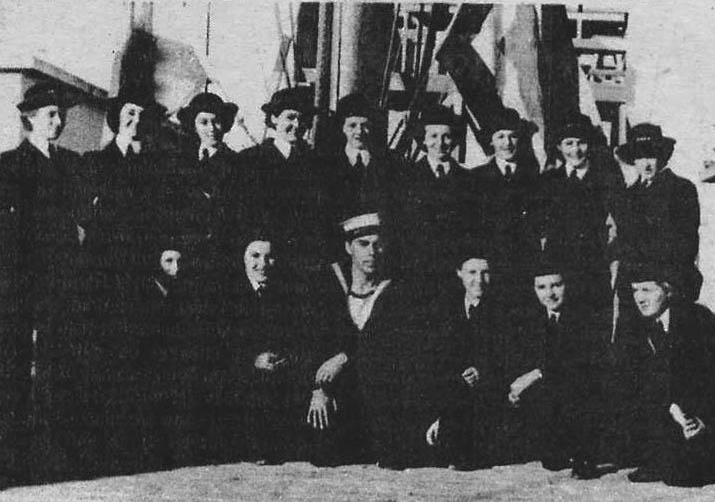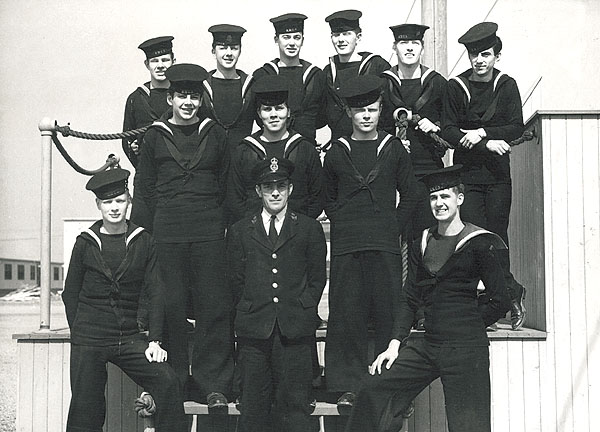This year of 1986 will mark the 45th anniversary of the commissioning
of HMCS HYACINTHE and February 20 was the 40 the anniversary of its "paying
off". Is this yet another story of one our proud Corvettes or perhaps a
heroic epic of a Canadian WWII era destroyer? Neither of these! ST. HYACINTHE
was the Royal Canadian Navy's Communications School during the Second World
War and was situated 35 miles east of Montreal. At its peak, the student
population reached about 2,600 and during its almost five years of service
ST. HYACINTHE trained 9,600 sailors, WRENS and Signal Officers in the many
skills of naval communications. At the time it was considered to be the
biggest signals school in the British Empire. It should be noted that in
1985 the entire student population in Fleet School Halifax never exceeded
1,530.
There are few left who remember "ST. HY" (as it was affectionately known)
but many are familiar with some of the names associated with the school.
In charge of Visual Instruction then was Lt. J.C. O'Brien, Commander of
Maritime Command during the rocky integration years, in the late 1960's.
Know affectionately by all as "Scruffy O'Brien", he remained a favourite
of Canadian Naval Communicators and the annual communications competition
still bears his name as does the annual prestigious cup awarded to the
ship with the best communicators.
Among the first officers to graduate from the "Long Signal Course" was
a young Lieutenant by the name of H.A. Porter. "Harry" Porter also became
Commander Maritime Command , occupying the hot seat throughout 1970 and
1971. After leaving the Canadian Navy he became Chairman of the Nova
Scotia Police Commission and still holds that position. Communicators also
show favoritism to VADM Porter and have named their annual Golf Tournament
in his honour.
ST. HYACINTHE was a busy thriving naval establishment and the
course load was heavy for both staff and students. The skills of Semaphore,
Flashing Light, Morse Telegraphy and Typing were instilled into prairie
farmers, factory workers, fisherman and any other young man determined
to go to sea as a "Sparker" or a "Bunting". Other subjects were also taught
this the communications school. Many hours were spent teaching "Coders",
the secret ciphers and techniques required for war time communications.
"Radio Artificers" were shown the mysteries of vacuum theory and taught
the required skills for maintaining their own transmitters and receivers.
WRCNS (WREN) Officers were given specialist courses to enable them to
carry out the duties of Signals Officers at shore bases. WRCN ratings were
also trained as radio and signal operators for shore duty, freeing the
men for the ever increasing number if ships at sea. For the WRENs who took
the W/T (Special Operator course) it was 160 days in duration. That
was not even for sending, only receiving.
 |
| This was the very first WREN graduating class from St. HYACINTHE
- July to November 1943. (Photo courtesy Maritime Command Museum) |
Officers of the Executive Branch undertook their communications training
at "ST. HY". This enabled them to carry out their duties as Communications
Officers both ashore and afloat. Our present day NCI Operator and Tactical
Team Trainer can also trace their roots to "ST. HY".
With the introduction of radar and the decision to outfit new frigates
with Action Information Centres in 1944, a special "HMC Action Information
School was set up at St. Hyacinthe to teach officers and ratings theory
and procedures for this system of the future.
Even though it remained in existence for only five years, ST. HYACINTHE,
like many other things which link to the RCN during WWII, holds a distinguished
place in the history of the Naval Service of Canada. The Communications
Section of Fleet School Halifax is now only a handful of classrooms and
a few signal towers but the tradition carries on. In the hallway of the
present Comm School is a large Honour Roll of Naval Communicators who lost
their lives at sea. Many of these were trained at ST. HYACINTHE. As well,
a new classroom was inaugurated in early 1984 to train operators in the
Computerized Message Handling System. The room has been named ST. HYACINTHE
to honour an establishment which had no equal in the Commonwealth during
the dark days of World War II.


